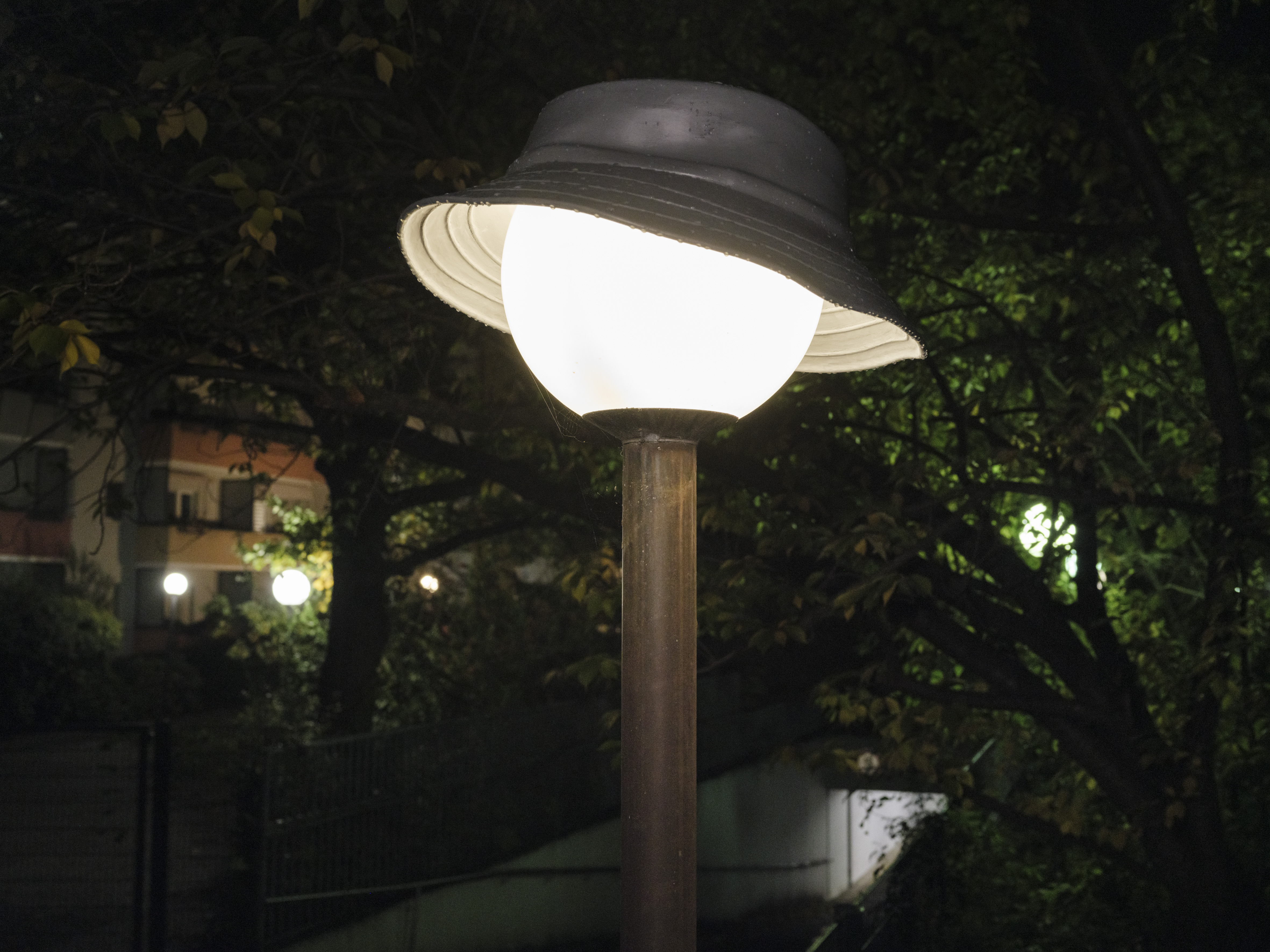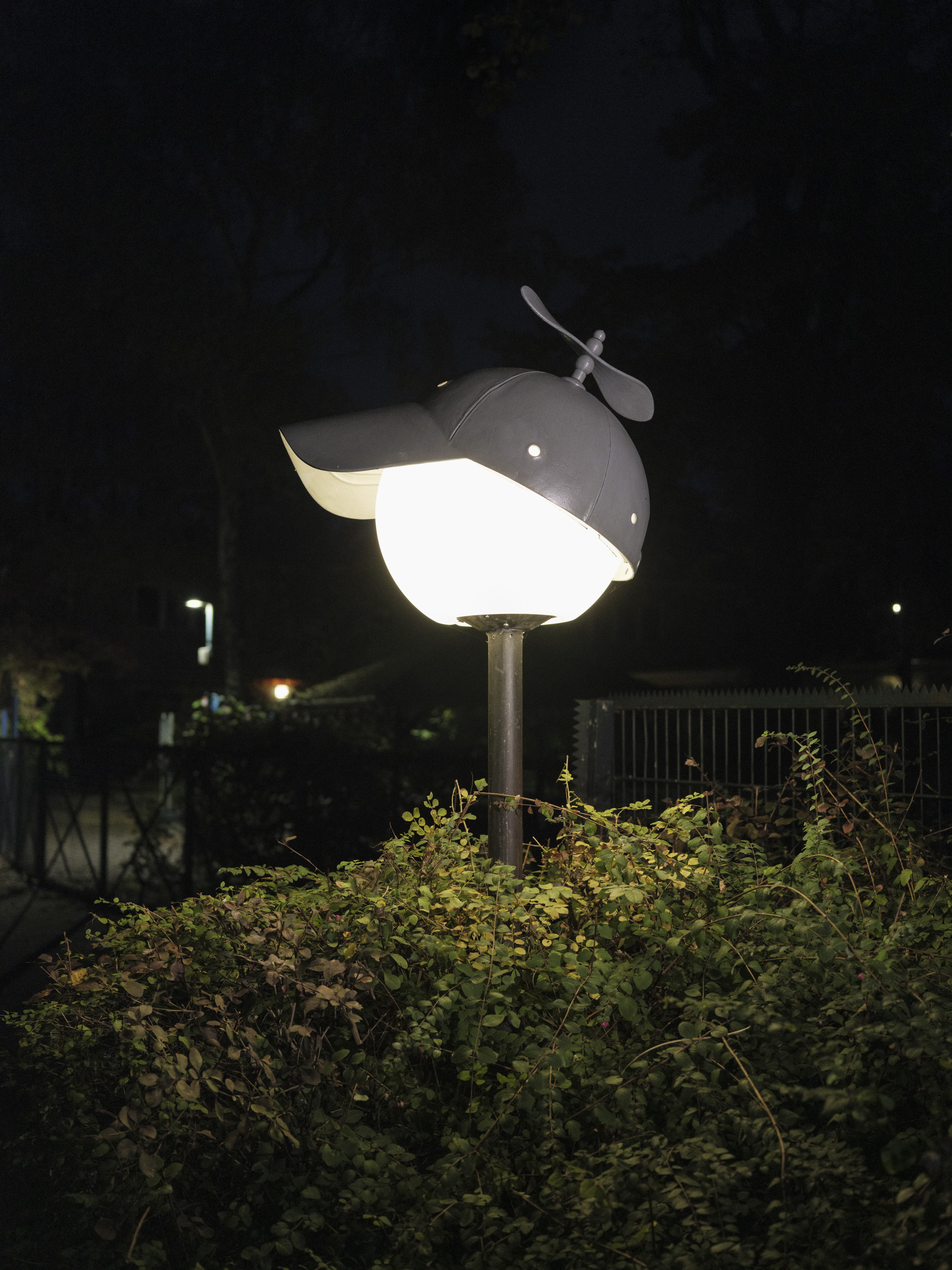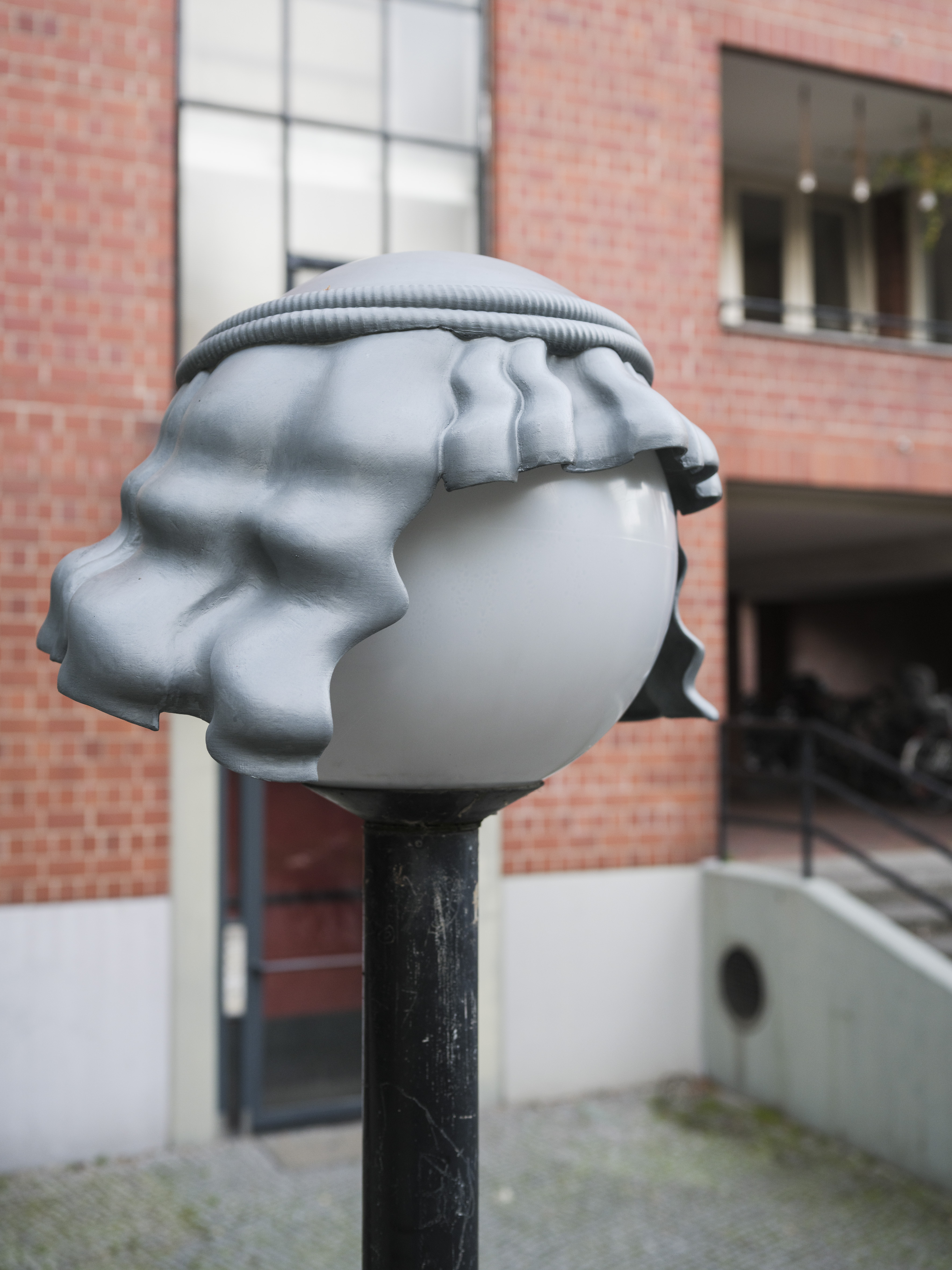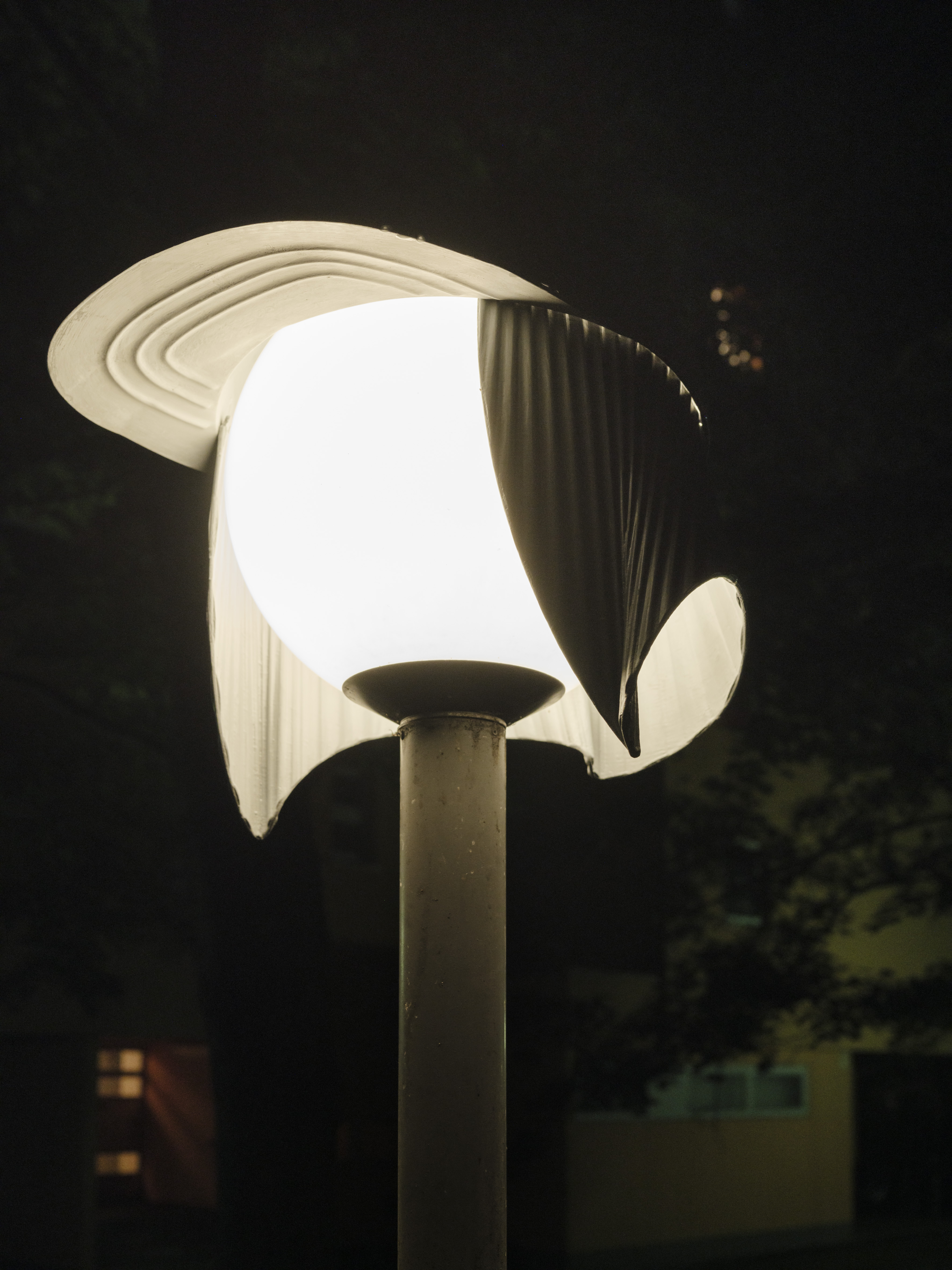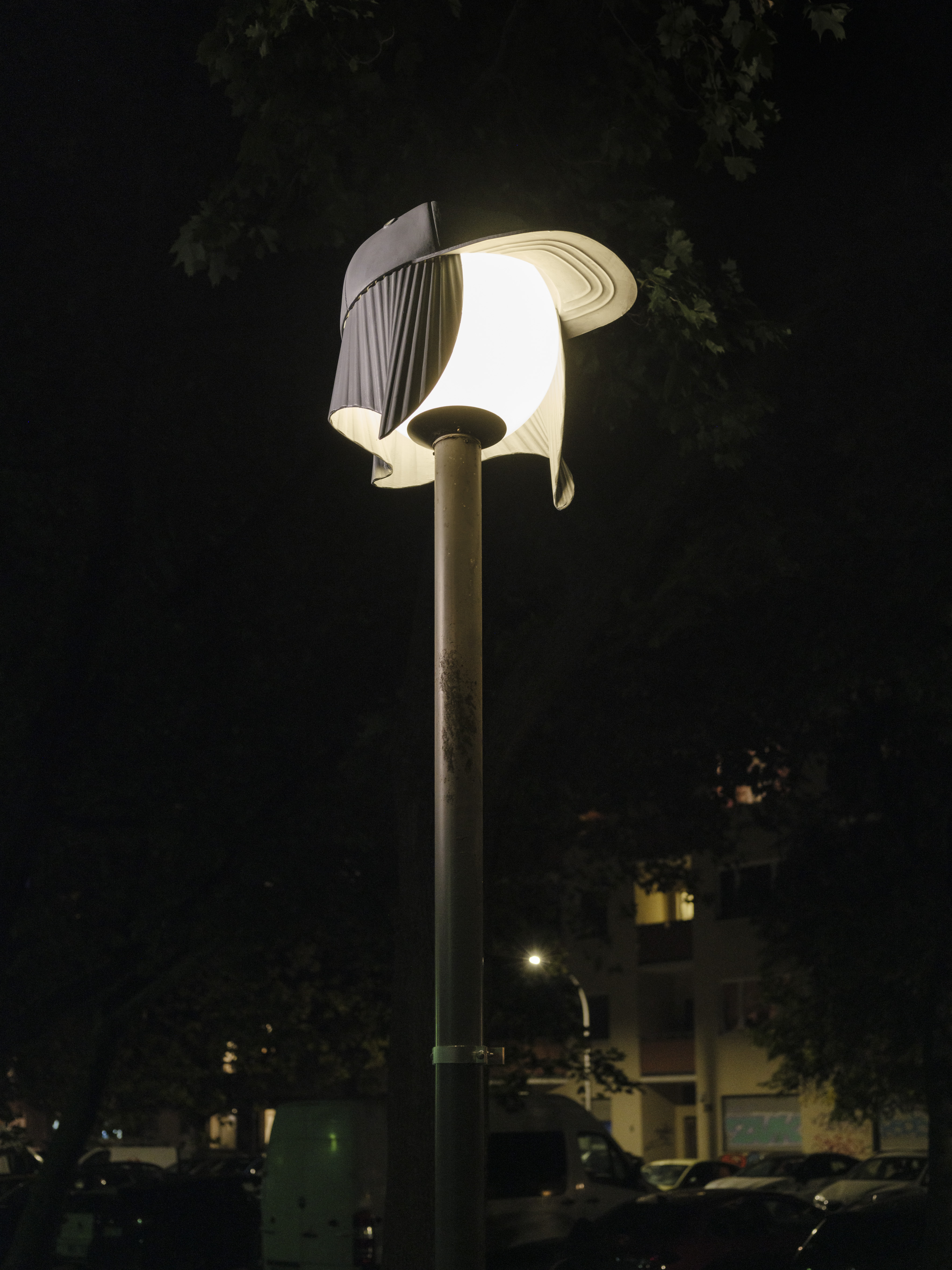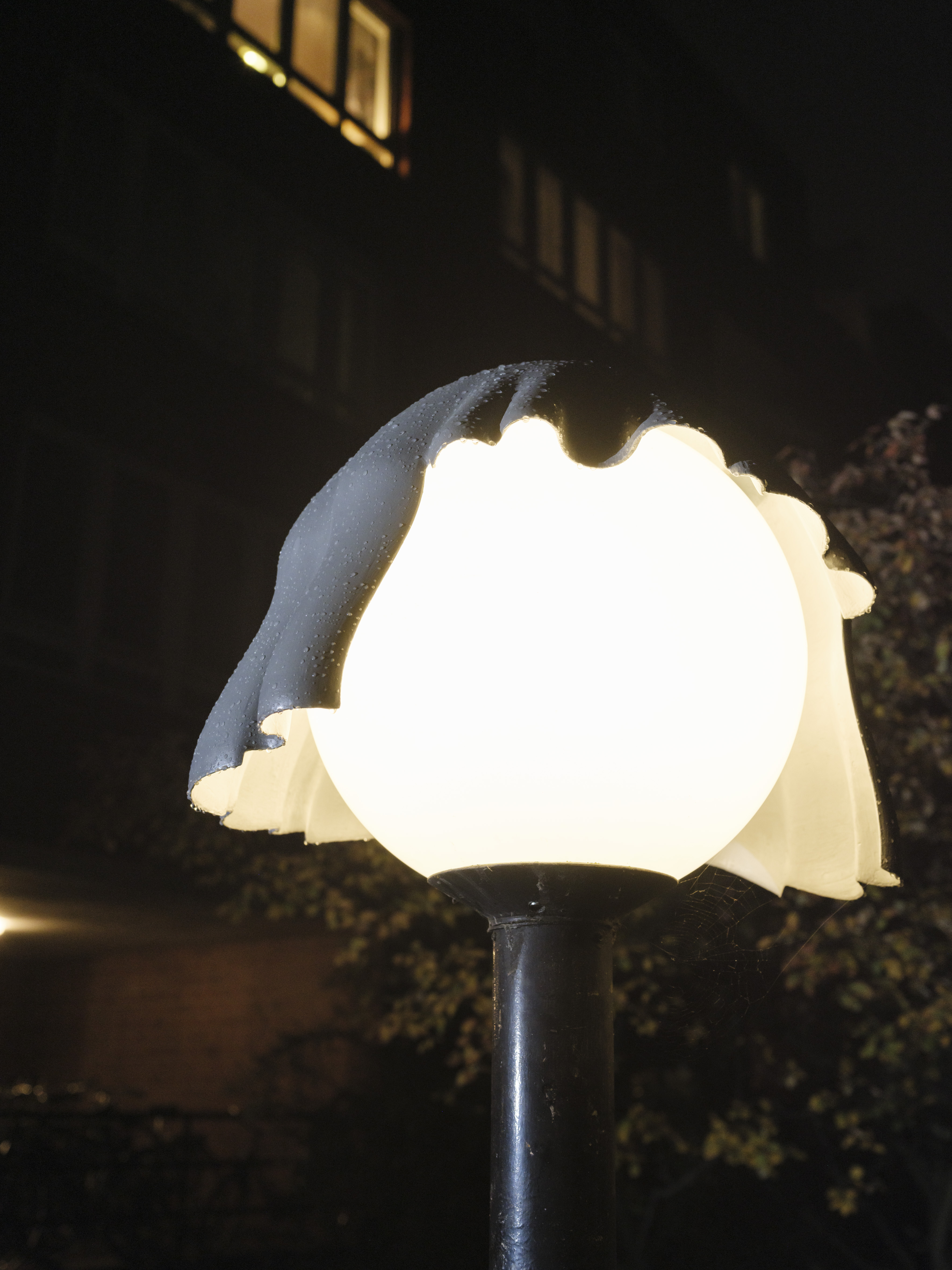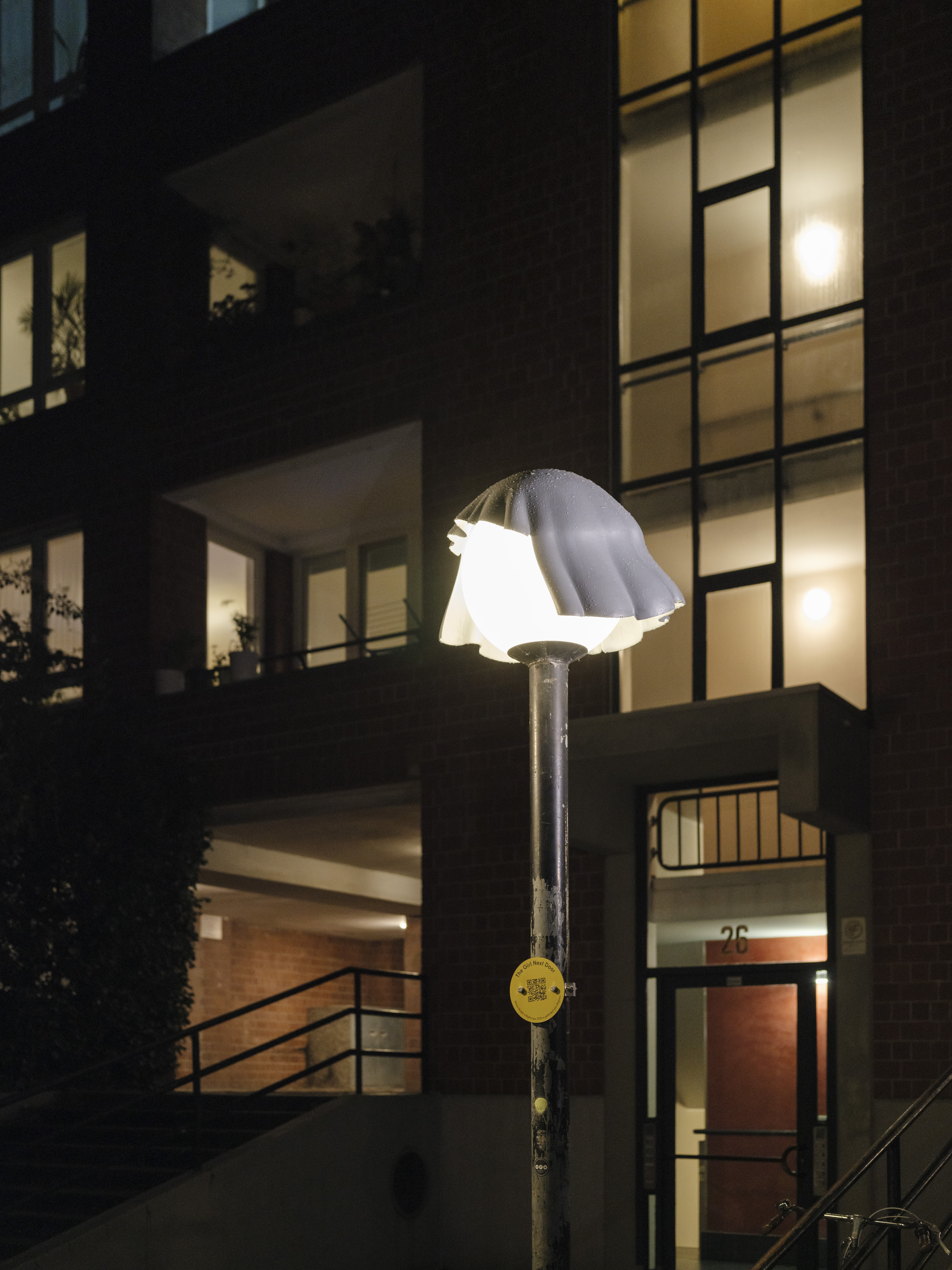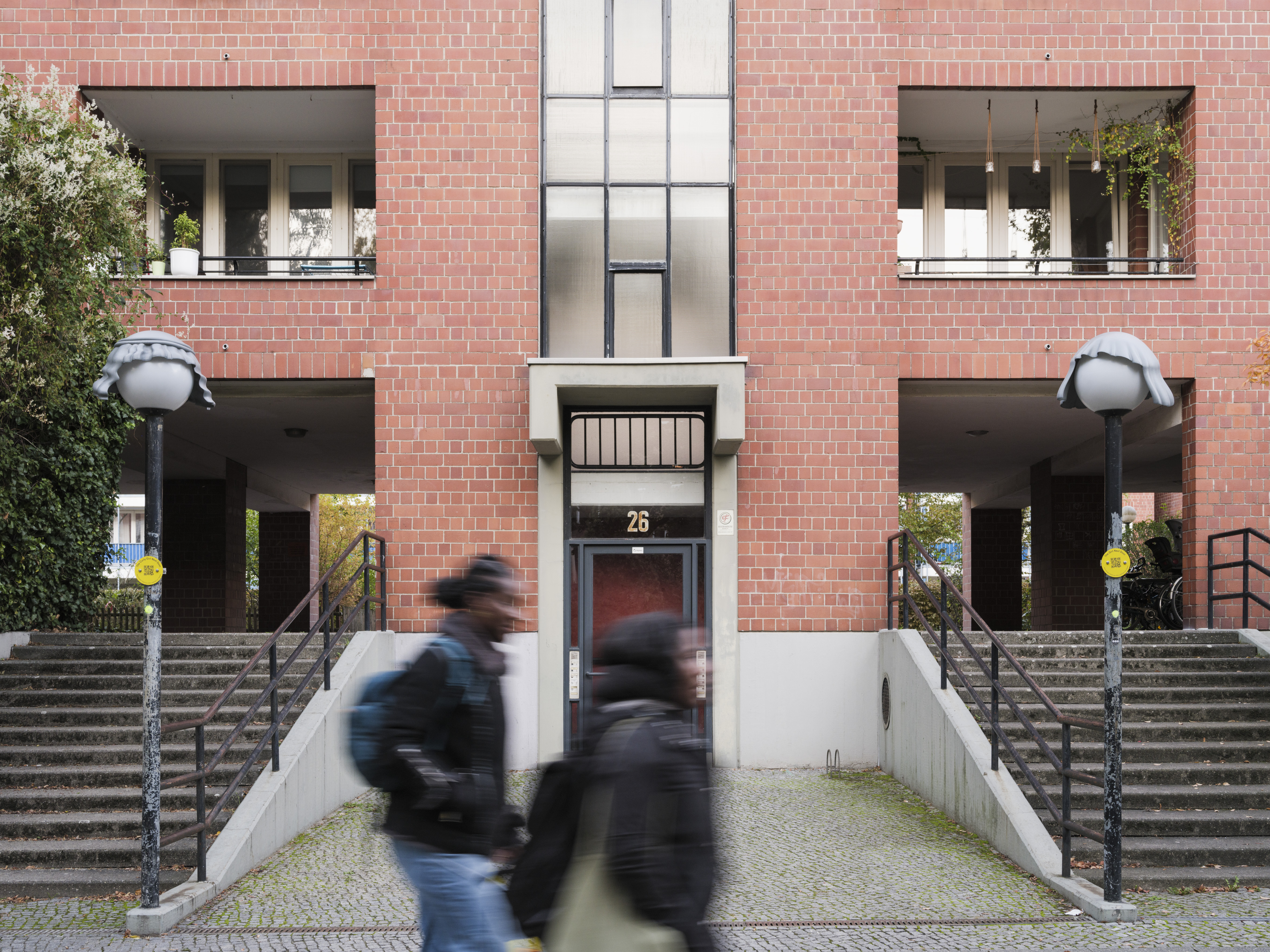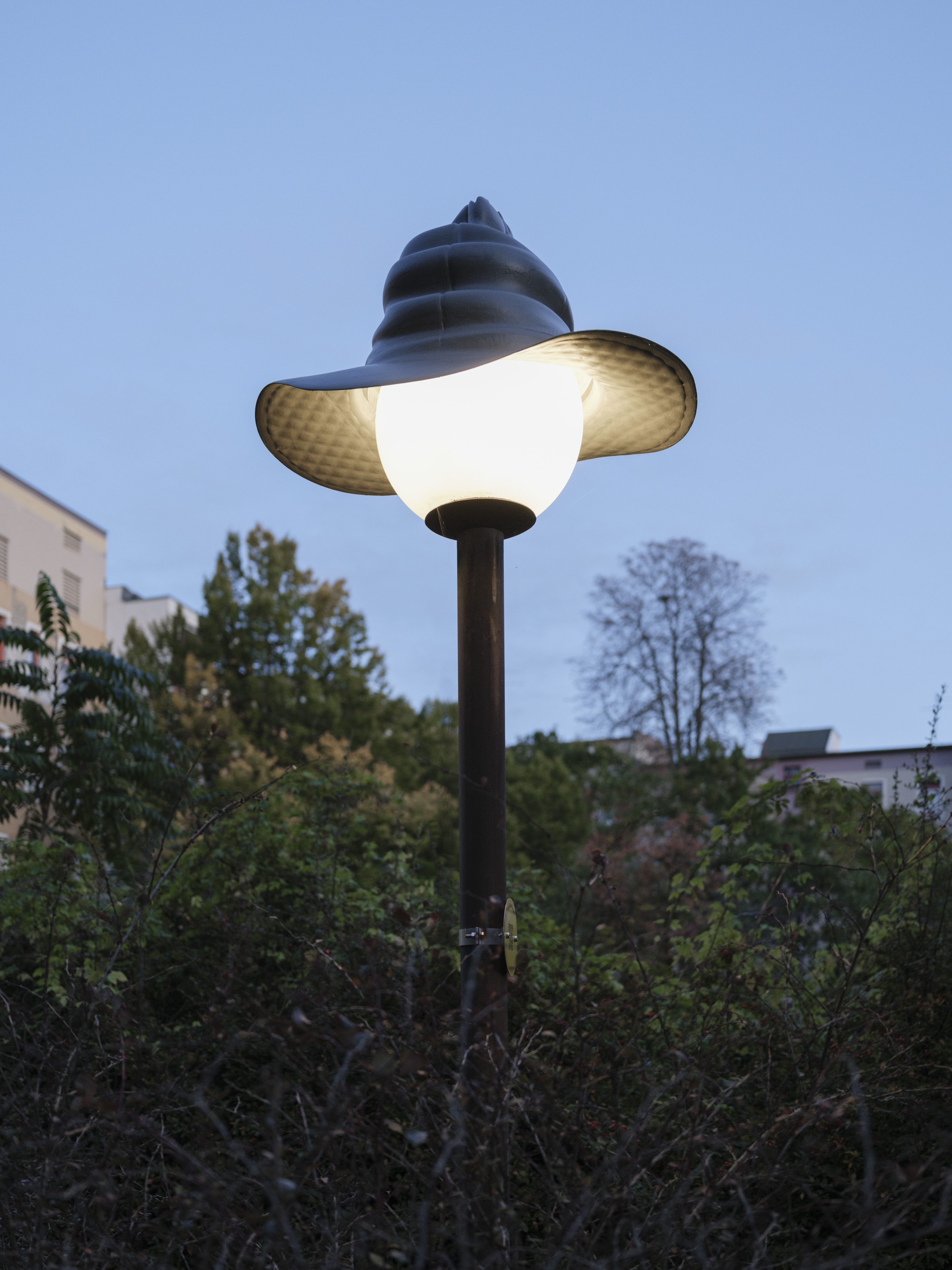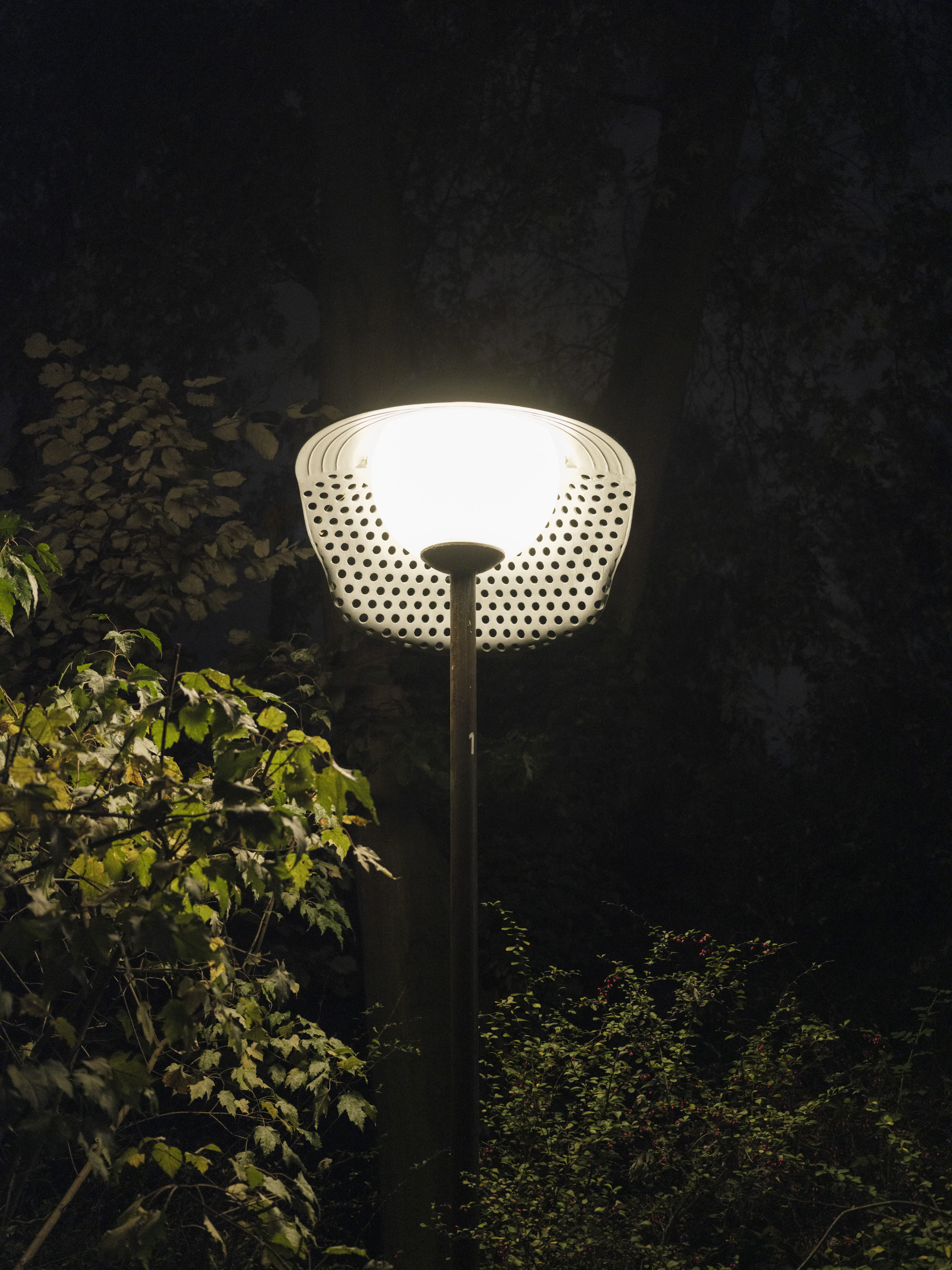Reconnecting with nature
Nightcaps
Nightcaps, a Series of Street Lamps with Sculptures on Top
Spherical street lamps are installed in many courtyards and pathways in European cities and towns, providing soft, even romantic light. But these lanterns glow in all directions, which adds light pollution to our cities. Nightcaps is a series of sculptures that ensure that light only shines downwards - in a playful, surprising, and culturally diverse way, addressing the under-valued topic of light pollution and its effects on humans and urban wildlife.
Germany
Local
Berlin Wedding
It addresses urban-rural linkages
It refers to a physical transformation of the built environment (hard investment)
Yes
2024-10-17
Yes
The project was financed by degewo AG
No
No
As an individual
"Nightcaps" is a public art project addressing light pollution through sculptural interventions on spherical street lamps in Berlin’s Brunnenviertel, a working-class neighborhood with a diverse population. Created by visual artist Alona Rodeh, which lives and works in Brunnenviertel and is an adovate of dark skies, the project rethinks urban illumination by combining sustainability, cultural diversity, and participatory design. A series of 9 unique sculptures, made from recycled PETG using large-scale 3D printing, redirect light downward to reduce light pollution, protect nocturnal wildlife, and improve human well-being while maintaining existing urban infrastructure.
Developed with community involvement, residents participated through questionnaires, design selection, and mapping preferred locations, ensuring local ownership. Supported by housing company degewo, which owns the street lanterns, the project has gained traction, leading to expansion plans and new collaborations. "Nightcaps" offers an accessible, playful, and scalable model for sustainable, community-driven urban lighting solutions worldwide.
Developed with community involvement, residents participated through questionnaires, design selection, and mapping preferred locations, ensuring local ownership. Supported by housing company degewo, which owns the street lanterns, the project has gained traction, leading to expansion plans and new collaborations. "Nightcaps" offers an accessible, playful, and scalable model for sustainable, community-driven urban lighting solutions worldwide.
Light Pollution
Art in Public Space
Biodiversity
Diversity
Repair
The project addresses light pollution—a significant but often neglected environmental issue—by installing sculptures made from durable 3D-printed recycled PETG atop spherical street lamps. These interventions redirect light downward, reducing pollution, supporting biodiversity in the city, and promoting a more sustainable night-time atmosphere.
"Nightcaps" promotes sustainability both symbolically and functionally by encouraging thoughtful and proposing playful urban lighting design. The sculptures act as artistic "shields," reducing unnecessary light spills while maintaining the essential function of street lamps. Each design explores varying degrees of light reduction, with some asymmetrically positioned to ensure that the open side faces the street while blocking light trespass into residential homes. This targeted approach balances safety, ecological responsibility, and human well-being.
Beyond the installations, the project fosters awareness through academic discussions, municipal outreach, guided night walks, and social media publications, advocating for artistic, joyful, and functional solutions to excessive urban lighting. Nightcaps offers a replicable model for cities seeking sustainable urban lighting interventions by demonstrating how existing infrastructure can be creatively adapted rather than replaced.
"Nightcaps" promotes sustainability both symbolically and functionally by encouraging thoughtful and proposing playful urban lighting design. The sculptures act as artistic "shields," reducing unnecessary light spills while maintaining the essential function of street lamps. Each design explores varying degrees of light reduction, with some asymmetrically positioned to ensure that the open side faces the street while blocking light trespass into residential homes. This targeted approach balances safety, ecological responsibility, and human well-being.
Beyond the installations, the project fosters awareness through academic discussions, municipal outreach, guided night walks, and social media publications, advocating for artistic, joyful, and functional solutions to excessive urban lighting. Nightcaps offers a replicable model for cities seeking sustainable urban lighting interventions by demonstrating how existing infrastructure can be creatively adapted rather than replaced.
Aesthetically, the sculptures have a playful appeal and represent cultural diversity, referencing traditional head coverings and transforming ordinary streetlights into poetic urban landmarks. Each design is inspired by certain "types" of people, and each lantern has a name tag that adds to its personality (for example, The Girl Next Door, the Voyager, etc). Nightcaps sets an example for sustainable urban interventions by demonstrating how thoughtful design can address ecological challenges while celebrating cultural diversity and enhancing the visual quality of public spaces.
Nightcaps is a site-specific public art project that reimagines urban lighting through the lens of design, playfulness, and cultural awareness. Rooted in Bauhaus principles of functional beauty, minimalism, and material consciousness, the project enhances the nocturnal cityscape by merging everyday infrastructure with artistic intervention. Modifying standard streetlights with custom-designed caps challenges the uniformity of urban design, creating a more engaging and humanized experience. The project fosters a new perception of public lighting—transforming it from a passive utility into an expressive, site-responsive element interacting with its surroundings. Through its conceptual clarity, simplicity, and innovative use of materials, 'Nightcaps' exemplifies how design can enrich public spaces, stimulate dialogue about urban ecologies, and encourage a more sustainable relationship with artificial illumination in the built environment.
Nightcaps is a site-specific public art project that reimagines urban lighting through the lens of design, playfulness, and cultural awareness. Rooted in Bauhaus principles of functional beauty, minimalism, and material consciousness, the project enhances the nocturnal cityscape by merging everyday infrastructure with artistic intervention. Modifying standard streetlights with custom-designed caps challenges the uniformity of urban design, creating a more engaging and humanized experience. The project fosters a new perception of public lighting—transforming it from a passive utility into an expressive, site-responsive element interacting with its surroundings. Through its conceptual clarity, simplicity, and innovative use of materials, 'Nightcaps' exemplifies how design can enrich public spaces, stimulate dialogue about urban ecologies, and encourage a more sustainable relationship with artificial illumination in the built environment.
The project first fostered inclusivity by installing the works in public spaces. Then, through a participatory design process, we engaged local residents in selecting, designing, and choosing installation locations for the sculptures. This approach ensured community voices were present in the project, fostering a sense of ownership and engagement.
Nightcaps is a fully accessible public art project that is free for all, mainly benefiting the neighborhood's residents. Funded by degewo, a housing company that owns both the lamps and many of the surrounding buildings, the project reflects its commitment to enhancing public spaces and addressing light pollution while being mindful of the hardships faced by the area's low-income residents. By transforming familiar urban infrastructure, "Nightcaps" offers a welcoming and inclusive experience, ensuring that art is not confined to galleries but integrated into daily life. Its permanent installation in the streets of Berlin is both physical and conceptual—anyone can engage with it, regardless of background. Looking ahead, degewo supports my plans to expand the project with more installations and deeper community engagement, including workshops for children and teenagers, empowering them to co-create and install future works in 2025.
Nightcaps is a fully accessible public art project that is free for all, mainly benefiting the neighborhood's residents. Funded by degewo, a housing company that owns both the lamps and many of the surrounding buildings, the project reflects its commitment to enhancing public spaces and addressing light pollution while being mindful of the hardships faced by the area's low-income residents. By transforming familiar urban infrastructure, "Nightcaps" offers a welcoming and inclusive experience, ensuring that art is not confined to galleries but integrated into daily life. Its permanent installation in the streets of Berlin is both physical and conceptual—anyone can engage with it, regardless of background. Looking ahead, degewo supports my plans to expand the project with more installations and deeper community engagement, including workshops for children and teenagers, empowering them to co-create and install future works in 2025.
Residents were engaged via a questionnaire introducing the project, allowing them to vote on designs, sketch their ideas, and suggest installation locations on a neighborhood map. This ensured the project reflected their cultural identity and spatial preferences, making it a community-driven intervention. This process made the local residents more involved, and their comments added to the design process's depth and democratization.
By repurposing existing street lamps, the project addresses sustainability without adding environmental strain while raising awareness of light pollution. It remains free, accessible, and inclusive, enhancing public space for all. Looking ahead, degewo plans to expand "Nightcaps" through community workshops where children and teenagers will help design and install future works—deepening public engagement and fostering a shared sense of ownership over urban space.
By repurposing existing street lamps, the project addresses sustainability without adding environmental strain while raising awareness of light pollution. It remains free, accessible, and inclusive, enhancing public space for all. Looking ahead, degewo plans to expand "Nightcaps" through community workshops where children and teenagers will help design and install future works—deepening public engagement and fostering a shared sense of ownership over urban space.
"Nightcaps" engaged stakeholders at multiple levels, shaping the project’s development and reach. Initially, the project was proposed to the city, but as the street lamps were not city-owned, they declined involvement, but were informed of the results and expressed their support. However, degewo, the housing company, stepped in to finance and support the initiative, ensuring its realization.
At the local level, we collaborated with neighborhood initiatives in Brunnenviertel, which helped promote the opening event and guided night walks that deepened public engagement. Moving forward, key community players—especially Olof-Palme-Zentrum, the neighborhood's most active, will take a more active role, expanding outreach and participation. Each “Nightcap” has a sign with the name of the specific piece, for example, The Traveller, The Girl Next Door, or The Curly Girl Next Door; the name gives a sense of direction for the “character” of the nightcaps, and a QR code is stamped on each sign, providing more info about the project online.
On a broader scale, the project has been accepted into Bauhaus Lab 2025: After Modern Brightness at Bauhaus Dessau, where it will gain artistic and historical insights into modernist early 20th century urban lighting. This cross-disciplinary collaboration enhances the project’s design discourse, reinforcing its connection to Bauhaus principles and current topics of urban ecologies.
At the local level, we collaborated with neighborhood initiatives in Brunnenviertel, which helped promote the opening event and guided night walks that deepened public engagement. Moving forward, key community players—especially Olof-Palme-Zentrum, the neighborhood's most active, will take a more active role, expanding outreach and participation. Each “Nightcap” has a sign with the name of the specific piece, for example, The Traveller, The Girl Next Door, or The Curly Girl Next Door; the name gives a sense of direction for the “character” of the nightcaps, and a QR code is stamped on each sign, providing more info about the project online.
On a broader scale, the project has been accepted into Bauhaus Lab 2025: After Modern Brightness at Bauhaus Dessau, where it will gain artistic and historical insights into modernist early 20th century urban lighting. This cross-disciplinary collaboration enhances the project’s design discourse, reinforcing its connection to Bauhaus principles and current topics of urban ecologies.
"Nightcaps" is a multidisciplinary project that combines functionality and artistic concepts, merging urban design, product design, sculpture, and cultural research. The design process was rooted in closely observing the surrounding human environment, drawing inspiration from head coverings and street hairstyles. By gathering references from online sources and real-life encounters, I collaborated with a product designer to develop a series of evolving sculptures that represent various recognizable ‘types’ from public life - on a range from concrete to fantasy-like. The street lamps’ simple round shape served as a universal yet locally resonant base, allowing us to merge formal and cultural reference points. The dialogue between artistic vision and product design ensured conceptual depth and technical feasibility. The project’s added value lies in its ability to blend everyday familiarity with artistic intervention, making urban infrastructure more engaging while subtly reflecting the social diversity of its community.
“Nightcaps" introduces a unique, artistic approach to urban illumination, standing apart from the highly technical focus of mainstream street lighting trends. While European municipalities are increasingly aware of over-illumination, existing solutions remain industrial and functional, lacking a playful or cultural dimension and local sensitivity. This project serves as a blueprint for creative, community-driven responses to the issue, using humor and design to engage the public in a conversation about nighttime and the ability to unwind in this technology-saturated world. The project is supported by periodical night walks through the different works installed, sharing my experience from the production process and the topic it addresses.
Unlike conventional urban lighting upgrades that replace fixtures at high costs, "Nightcaps" advocates reinterpreting and repurposing existing luminaires, making transformation more sustainable and cost-effective, providing solutions on a micro-level. The project challenges the status quo by bridging artistic intervention with environmental awareness, demonstrating that urban lighting can be both aesthetic and ecologically responsible without relying solely on large-scale infrastructure changes. The seeds of this project were planted in CURRENT – ART AND URBAN SPACE, Stuttgart, in 2021; its expanded pilot was installed in Brunnenviertel, Berlin, in 2024, and it can be installed anywhere where there are spherical street lights - which is in many, many parks and pedestrian routes in Europe. With the New European Bauhaus, I wish to reach a wider audience and install unique Nightcaps wherever possible, emphasizing work through local communities and their unique characterizations.
Unlike conventional urban lighting upgrades that replace fixtures at high costs, "Nightcaps" advocates reinterpreting and repurposing existing luminaires, making transformation more sustainable and cost-effective, providing solutions on a micro-level. The project challenges the status quo by bridging artistic intervention with environmental awareness, demonstrating that urban lighting can be both aesthetic and ecologically responsible without relying solely on large-scale infrastructure changes. The seeds of this project were planted in CURRENT – ART AND URBAN SPACE, Stuttgart, in 2021; its expanded pilot was installed in Brunnenviertel, Berlin, in 2024, and it can be installed anywhere where there are spherical street lights - which is in many, many parks and pedestrian routes in Europe. With the New European Bauhaus, I wish to reach a wider audience and install unique Nightcaps wherever possible, emphasizing work through local communities and their unique characterizations.
“Nightcaps" follows a research-driven, participatory, and site-responsive approach, integrating design, cultural observation, and community engagement. The process began with exploring urban lighting to re-introduce darkness to cities and reduce light pollution, taking the existing street lamps as a starting point. Inspired by head coverings and hairstyles seen in the neighborhood, we gathered references from online sources and real-life encounters to develop sculptural designs that resonate with the local context.
We mapped all the relevant lanterns in the neighborhood. Then, to ensure community involvement, we conducted a questionnaire, inviting residents to vote on designs, sketch their ideas, and suggest installation locations based on the maps we provided them. This participatory process informed the final selections, creating a sense of ownership among citizens. The project prioritizes adaptive reuse, adapting existing luminaires rather than replacing them, making it a sustainable and modular choice of action. The final selection of locations was based on matching the particular designs with the local landscape and landmarks where they were installed.
By merging artistic experimentation with public engagement, Nightcaps transforms functional infrastructure into a cultural and ecological dialogue, raising awareness of a topic often untreated.
We mapped all the relevant lanterns in the neighborhood. Then, to ensure community involvement, we conducted a questionnaire, inviting residents to vote on designs, sketch their ideas, and suggest installation locations based on the maps we provided them. This participatory process informed the final selections, creating a sense of ownership among citizens. The project prioritizes adaptive reuse, adapting existing luminaires rather than replacing them, making it a sustainable and modular choice of action. The final selection of locations was based on matching the particular designs with the local landscape and landmarks where they were installed.
By merging artistic experimentation with public engagement, Nightcaps transforms functional infrastructure into a cultural and ecological dialogue, raising awareness of a topic often untreated.
"Nightcaps" is highly modular and adaptable, easily transferable to different locations, communities, and scales. Depending on budget and conditions, the project can be implemented with 1, 10, or 1000 units. While the current series emphasizes uniqueness, using 3D-printed recycled plastic, larger-scale productions could explore other durable, sustainable materials and techniques. The concept is widely applicable and scalable, as spherical street lanterns remain common in Europe and beyond, especially in parks and pedestrian areas. In such locations, shielding light upward improves biodiversity and awareness, making Nightcaps an artistic and ecological intervention.
Furthermore, the co-creative approach ensures each adaptation reflects local cultures and identities. By engaging different communities in the design process, the project fosters inclusive, site-specific transformations, proving that urban lighting can be both sustainable and culturally meaningful.
Furthermore, the co-creative approach ensures each adaptation reflects local cultures and identities. By engaging different communities in the design process, the project fosters inclusive, site-specific transformations, proving that urban lighting can be both sustainable and culturally meaningful.
Light pollution is a growing global concern, exacerbated by the widespread use of LEDs and the omnipresence of screens in the daily lives of all humans, from toddlers to the elderly. This excessive artificial illumination disrupts human circadian rhythms, leading to sleep disorders and associated health issues. Not less important, it adversely affects urban wildlife, interfering with behaviors such as migration, foraging, and reproduction.
"Nightcaps" addresses this challenge by implementing local, community-driven solutions in Berlin's Brunnenviertel neighborhood. As a neighborhood resident, I installed artistic caps on street lamps to reduce upward light spills and raise awareness about light pollution. This initiative enhances the aesthetic appeal of our streets and fosters a sense of community ownership and responsibility towards our shared environment.
By focusing on local engagement and creative design, "Nightcaps" offers a scalable model that can be adapted by other communities worldwide to combat the pervasive issue of light pollution.
"Nightcaps" addresses this challenge by implementing local, community-driven solutions in Berlin's Brunnenviertel neighborhood. As a neighborhood resident, I installed artistic caps on street lamps to reduce upward light spills and raise awareness about light pollution. This initiative enhances the aesthetic appeal of our streets and fosters a sense of community ownership and responsibility towards our shared environment.
By focusing on local engagement and creative design, "Nightcaps" offers a scalable model that can be adapted by other communities worldwide to combat the pervasive issue of light pollution.
Light pollution is a growing global concern, exacerbated by the widespread use of LEDs and the omnipresence of screens in the daily lives of all humans, from toddlers to the elderly. This excessive artificial illumination disrupts human circadian rhythms, leading to sleep disorders and associated health issues. Not less important, it adversely affects urban wildlife, interfering with behaviors such as migration, foraging, and reproduction.
"Nightcaps" addresses this challenge by implementing local, community-driven solutions that are installed in one location, but could be installed in many other places where these lanterns are still in use. This initiative enhances the aesthetic appeal of our streets and fosters a sense of community ownership and responsibility towards our shared environment. By focusing on local engagement and creative design, "Nightcaps" offers a scalable model that can be adapted by other communities worldwide to combat the pervasive issue of light pollution.
In addition to light pollution, the main other challenge in this project is vandalism. One of the Nightcaps has disappeared, and another one was partially destroyed. We are working on securing the sculptures in a better way for the future, and with additional mediation - there is a better chance for preventing that from happening again.
"Nightcaps" addresses this challenge by implementing local, community-driven solutions that are installed in one location, but could be installed in many other places where these lanterns are still in use. This initiative enhances the aesthetic appeal of our streets and fosters a sense of community ownership and responsibility towards our shared environment. By focusing on local engagement and creative design, "Nightcaps" offers a scalable model that can be adapted by other communities worldwide to combat the pervasive issue of light pollution.
In addition to light pollution, the main other challenge in this project is vandalism. One of the Nightcaps has disappeared, and another one was partially destroyed. We are working on securing the sculptures in a better way for the future, and with additional mediation - there is a better chance for preventing that from happening again.

